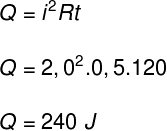O It is madeJoule is a physical phenomenon that consists of conversion ofenergyelectricin heat. This phenomenon occurs when an electrical current passes through any body. The constant collisions that occur between the electrons and the atoms that make up the crystal structure of the body cause its temperature increases, causing part of the electrical energy contained in the charge carriers to be converted into heat.
Lookalso:What is the speed of the electric current?
Joule Effect Formula
From the joule's law, it is possible to calculate the amount of heat dissipated by a conductor that is traversed by an electric current. To make use of this law, it is necessary that the electrical resistance of the material is constant, as well as the electrical current that passes through it.

Q – heat (J or lime)
i – electric current (A)
R – electrical resistance (Ω)
t – time interval(s)
The formula shown shows that the amount of heat that is dissipated is directly proportional to the square of the electrical current multiplied by electrical resistance and by the length of time the current took to cross the body.
Lookalso: Physics Discoveries That Happened By Accident
Joule Effect Utilities
Thanks to the Joule effect, it is possible to convert electrical energy into heat, as we do in:
- showers,
- crockpots,
- electric grills,
- irons etc.
The Joule effect occurs on any material, conductor or insulator, which has non-zero electrical resistance.
This phenomenon is more expressive in materialsinsulators, whose electrical resistances are generally higher. However, when insulating materials are traversed by intense electrical currents, it is possible that they arise in them defects irreparable due to the large increase in temperature.

Risks related to the Joule effect
The main risks related to the Joule effect arise from the temperature increase. In electrical installations, conductive wires and other electronic devices are required to operate at safe temperatures, however factors such as installationssloppy, presenceinmoisture,dustinexcess,threadspeeled and the oxidationof electronic components can cause their electrical resistances to increase, leading to greater heat dissipation, thus increasing the chances of occurrence of fires, for example.
Lookalso:All about Calorimetry
Joule effect experiment
They exist experiments in low cost is enough accessible that can be done in the classroom to evidence the existence of the Joule effect. One of them is to touch the terminals of a 9V battery in a piece of steel wool.
When we touch the steel wool to the battery terminals, an electrical current is formed, thus, the heating process. Quickly, the temperature of the steel wool increases until it turns red hot.
Heads up: this experiment can cause burns and fires, only perform it in the presence of parents or guardians. |
Exercises on the Joule Effect
Question 1) A conducting wire with an electrical resistance equal to 0.5 Ω is traversed by an electrical current of 2.0 A during a period of time of 2.0 minutes. Determine the amount of heat dissipated by this wire in joules.
a) 240 J
b) 4 J
c) 400J
d) 40 J
e) 120 J
Template: Letter a
Resolution:
To calculate the amount of heat dissipated, it is necessary to use Joule's law:

Question 2) Regarding the Joule effect, check what is correct.
a) The Joule effect only occurs at high temperatures.
b) The Joule effect arises from collisions between charge carriers and the atoms that make up the material's crystal lattice.
c) It is possible to control the energy loss by the Joule effect by increasing the intensity of the electric current.
d) The amount of heat that is dissipated by the Joule effect is inversely proportional to the electrical resistance of the material.
e) Conductive materials are not subject to the Joule effect.
Template:Letter B
Resolution:
Let's look at the answers:
The) FALSE – the Joule effect can occur at any temperature, however, this effect increases at high temperature regimes.
B) REAL
ç) FALSE - the amount of heat dissipated by the Joule effect is directly proportional to the square of the current intensity.
d) FALSE - the amount of heat dissipated by the Joule effect is directly proportional to the modulus of electrical resistance.
and) FALSE – all materials that have electrical resistance are subject to the Joule effect.
Question 3) A conducting wire is carried by an electric current of 0.5 A for 30 s. Since the electrical resistance of this wire is equal to 0.8 Ω, the amount of calories released by the wire during this period of time, due to the Joule effect, is equal to
Data: 1 cal = 4 J
a) 15.0 cal.
b) 12.0 cal.
c) 1.5 cal.
d) 6.0 cal.
e) 4.5 cal.
Template: Letter C
Resolution:
We will use Joule's law to calculate the amount of heat that is dissipated by the conducting wire:

According to the calculation performed, the amount of heat that is dissipated by this conducting wire is 1.5 cal, so the correct alternative is the letter C.
By Me. Rafael Helerbrock

